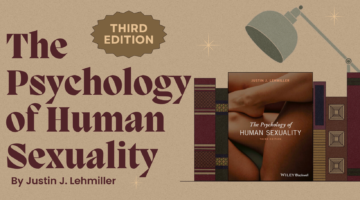Is Sexual Content In Movies Related To Sexual Risk Taking?
April 17, 2013 by Justin Lehmiller
Over the past two decades, sexual content in the movies and on television has become more explicit than ever before. These graphic depictions of sex have become a source of social concern for many parents, who worry that the increased visibility of sex in the media may lead adolescent viewers to imitate the behaviors they see on screen. This concern is compounded by the fact that most media depictions of sex portray it in risky and unrealistic terms. For example, an analysis of sexual content from the most popular movies released between 1983 and 2003 revealed that the vast majority of sex acts depicted (70%) occurred among people who had just met, and almost every scene (98%) failed to address the topic of contraception in any way [1]. Not only that, but virtually none of these sexual acts resulted in negative consequences (e.g., unintended pregnancies, STIs, etc.). So is parents’ concern warranted? Do such media depictions of sex have the potential to generate risky sexual behaviors among adolescents? A recent study published in Psychological Science suggests that they might.
In this study, researchers tracked 1,228 adolescents over a six-year period [2]. All participants were between the ages of 12 and 14 at the first assessment and between ages 18 and 21 at the last assessment. During the early assessments, participants were given a list of movies and were asked to indicate which ones they had seen. The researchers had coded each movie for amount of sexual content, which made it possible to approximate the total hours of sex participants had been exposed to. During the last assessment, participants were asked about the age at which they started having sex, as well as their total number of vaginal and oral sex partners to date and the number of times they had vaginal sex without a condom.
Results indicated that most teens (63%) became sexually active and, of those who did have sex, most waited until age 16 or later (85%), which is consistent with other studies. In addition, the more sexual content participants were exposed to in film, the younger they were when they first had sex. This association was stronger for boys than it was for girls. In addition, greater exposure to sexual content in the movies was linked to reporting a higher number of sex partners and a greater likelihood of having intercourse without a condom.
How do we explain this pattern of results? The researchers speculated and found some support for the idea that sexual content in the movies may increase sensation-seeking. Sensation-seeking is defined as a tendency to pursue new and exciting forms of stimulation, from sex to drugs to skydiving. Our sensation-seeking tendencies naturally increase during adolescence as a result of both biological and environmental factors. In this study, researchers found that adolescents exposed to more sexual content in the movies experienced greater increases in sensation-seeking, and this partially explained the observed changes in sexual behavior. Another way to think about this is that exposure to a large amount of sexualized media may “reset” our excitement threshold, leading us to require more intense forms of stimulation in order to meet it.
The longitudinal nature of this study suggests that early exposure to sex in the movies may ultimately lead adolescents to engage in riskier sexual behaviors—however, there are a few important caveats to this. For one thing, we don’t know for sure that media content caused the changes in sexual behavior because there may be a confounding variable the researchers failed to consider. For example, perhaps those adolescents who saw more sexual content in the movies also had less involved parents who provided less supervision. So maybe it is the kids’ relationship to their parents that is driving sexual behavior, not what they’re seeing at the cinema. In order to address this, the researchers statistically controlled for what they described as “maternal responsiveness” and “maternal demandingness”; however, I saw nothing in the article about controlling for characteristics of one’s father, which seems like an important oversight. There was also no assessment of peer attitudes and behaviors, which would presumably be a very important thing to consider as well. I should say that the researchers did control a few other factors, including frequency of church attendance, television watching habits, and race—however, this still doesn’t tell us conclusively what was causing adolescents to engage in risky sexual behaviors.
In addition, it is important to note that in statistical terms, the observed effects were in the small to medium range. What this means is that media exposure is only one small piece of the puzzle and there are likely many other factors that contribute to adolescent sexual behavior. In other words, even if we can blame the media, we can only blame it a little.
Although these findings do not represent the final word when it comes to the potential effects of sexual content in the media, they do suggest that this topic is worth further study. Moreover, these findings should not be taken to mean that all media depictions of sex are necessarily bad or that we should start censoring all sexual content. The authors of the study seem to suggest this conclusion; however, it seems quite premature given that the findings are by no means definitive. Also, if it is indeed the case that we imitate the sex that we see portrayed on screen, why is censoring out all of the sex the best course of action? Perhaps it would be even more effective to instead change the way that sex is portrayed so that it sets a good example and highlights the importance of sexual communication and safety.
Want to learn more about The Psychology of Human Sexuality? Click here for a complete list of articles or like the Facebook page to get articles delivered to your newsfeed.
[1] Gunasekera, H., Chapman, S., & Campbell, S. (2005). Sex and drugs in popular movies: An analysis of the top 200 films. Journal of the Royal Society of Medicine, 98, 464–470.
[2] O’Hara, R. E., Gibbons, F. X., Gerrard, M., Li, Z., & Sargent, J. D. (2012). Greater exposure to sexual content in movies predicts earlier sexual debut and increased sexual risk taking. Psychological Science, 23, 984-993.
Image Source: 123rf.com
You Might Also Like:

Dr. Justin Lehmiller
Founder & Owner of Sex and PsychologyDr. Justin Lehmiller is a social psychologist and Research Fellow at The Kinsey Institute. He runs the Sex and Psychology blog and podcast and is author of the popular book Tell Me What You Want. Dr. Lehmiller is an award-winning educator, and a prolific researcher who has published more than 50 academic works.
Read full bio >


